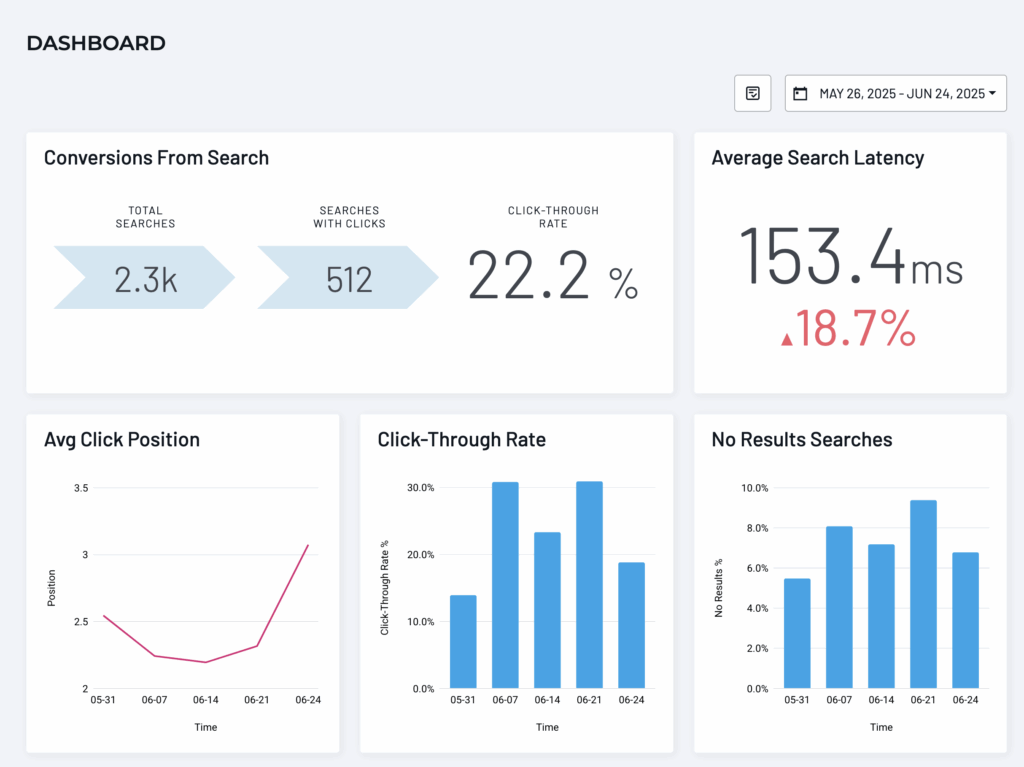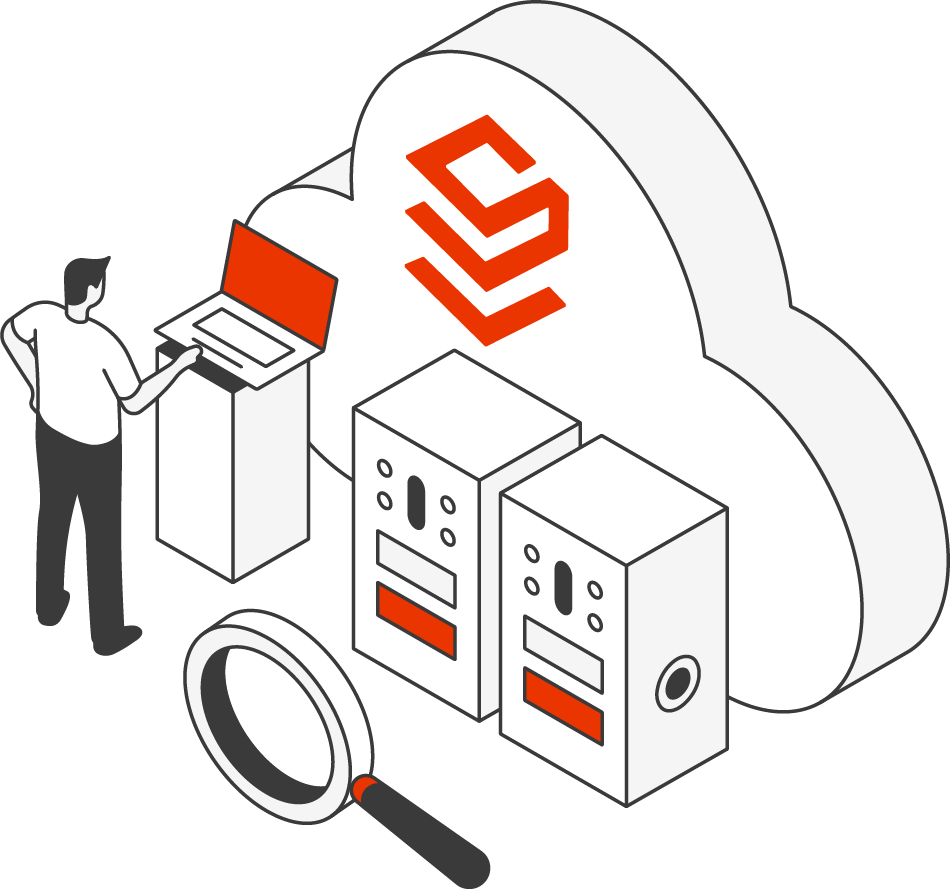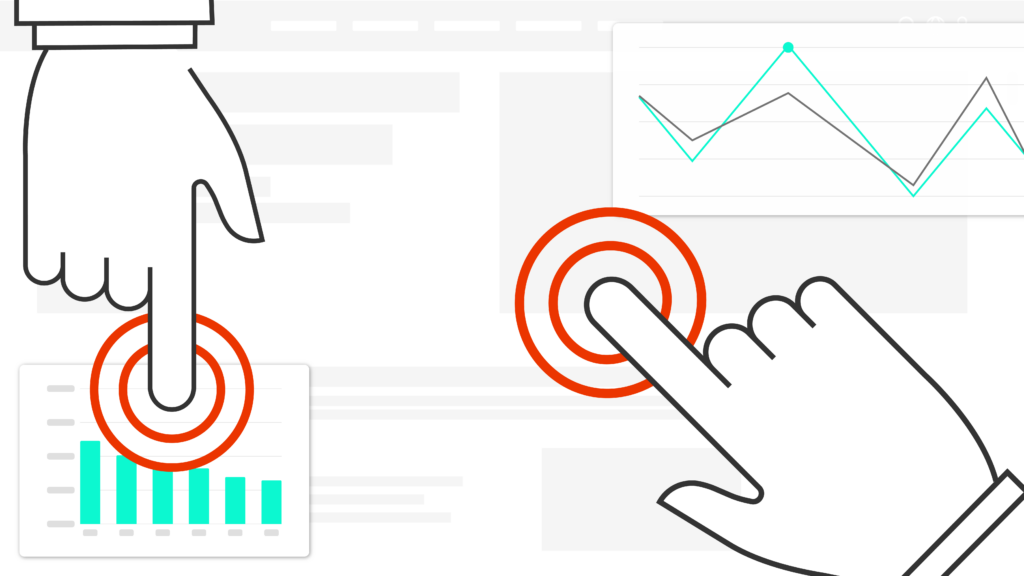July 19, 2024
John Abbasi
|
Website click-through rate is a great litmus test for marketing teams to understand their site and campaign performance. But many teams are missing the bigger picture by ignoring site search click-through rate.
A New View of Your Click-Through Rate
Click-through rate (CTR) is a longstanding performance metric used by marketing teams to determine the efficacy of their ads and listings in search engine results pages (SERP). Marketers tend to use common, fundamental strategies to track clicks from Google, which often leads to viewing CTR as a simple measure of how many people are clicking on their pages.
But this isn’t the whole picture of their entire domain’s click-through rate. That’s where site search CTR comes in. It changes the way we can track content performance and leverage click-through rate as a major tool for growth.
Let’s talk about how to improve your website CTR and cover all you need to know from the fundamentals to a new way to approach it with your onsite search data.
What is Click-Through Rate?
Click-through rate, commonly abbreviated “CTR,” is a digital marketing performance metric that measures the number of clicks on an advertisement or link compared to the number of times it is viewed. When a marketing team looks at CTR, they’re able to gauge how effective their campaigns are and how well they’re attracting people to their content.
The exact formula to calculate CTR is the number of clicks divided by the number of impressions (when a visitor sees your ad or search engine result).
CTR is expressed as a percentage. For example, if a webpage had 1,000 impressions and 23 clicks for a specific time period, the CTR would be 2.3% (calculated as 23/1,000).
What is a Good Click-Through Rate?
So what is considered a good click-through rate? It all depends on the industry, size and growth stage of the organization. If you’re well established in your industry and considered a market leader, it stands to reason that you’ll have greater success getting visitors to your site; benchmarking a “good” CTR would be higher, likely aiming in the 5% range from Google Ads.
If you’re less established or a growing organization, it’s best to temper expectations and set attainable goals for your campaigns’ CTR – in the 3% range (or even lower).
Generally, sources will tell you that a good CTR is in the 3-5% range. Take that as a rule of thumb but also with a grain of salt; your CTR goals should be aligned with your specific campaigns, webpages and growth stage within your industry.
Why is CTR Important?
Click-through rate is such an important factor for marketers whose primary goal is to connect with and further understand their potential customers. It gives you a basic blueprint that shows which types of webpages and campaigns succeed and which could use revision.
Furthermore, click-through rate can help increase your SEO success. A good CTR shows search engines that your pages are useful for visitors, validating the recommendation of your content and strengthening your authority.
It’s worth noting that although a good click-through rate can help you climb up SERP rankings, clicks alone aren’t the sole indicator of SEO health; bots and clickfarming are underhanded techniques that can artificially boost a website’s CTR, so major search engines like Google consider clicks important, but not the ultimate ranking factor.
Think of CTR as one of many contributing elements for SEO as well as a signpost for an SEO strategy that’s trending in the right direction.
What Factors Affect CTR?
What ends up boosting or hurting a CTR? Here are some of the most common factors to consider:
- URL structure. When someone performs a Google search, their results include a page’s URL. The recommended length is 75 characters. If the URL is too long or unhelpful, that person might conclude that it’s not what they’re looking for, or that the site is untrustworthy. Keep your URLs tight and on topic to indicate that your page is what visitors are looking for.
- Meta descriptions. A meta description, which is the text that describes a webpage on a search result, is more than just a brief rundown of a webpage with some important keywords placed in it. Think of it like a chance to capture your target audience’s attention while explaining what they’ll experience if they click on to your page. It’s one of the key factors in making an impression directly on the SERP. Recommended length of a meta description is 105 characters.
- Rich snippets. In a search result, a rich snippet lands underneath a specific result, often adding extra information such as a starred rating. These additions give visitors further incentive and peace of mind to click a result. Ensure that your site’s structured data is set to signal to Google which type of rich snippets you wish to capture.
- Mobile optimization. Website traffic across the internet has gone increasingly mobile. People have grown accustomed to the convenience of an internet browser in their pocket. As such, your website should be structured to deliver a mobile-friendly experience.
Content quality. They say content is king and this still holds true. If you consistently create well-researched, creative and insightful content, that is on-topic and relevant, your CTR will get a boost. This is particularly important for organic CTR, which measures how well your non-paid SERP listings are performing; the higher you rank your content in search engines, the larger your share of clicks for specific keywords and search queries will be.
- Headline efficacy. A good headline can turn heads, as it’s a way to creatively signal to potential visitors that the content you’ve created inside your page is what they’re in need of. Make sure headlines are direct and to the point that they discuss, and don’t be afraid to use questions in headings to direct visitors to the questions they need answered. Once visitors land on your page, heading hierarchy is important too, with subheadings nesting logically in overarching sections where appropriate.
Evaluating Your Current Website CTR
The first thing you’ll need when evaluating CTR is a tool that accurately measures it. Popular tools like Google Analytics, Google Ads, Google Search Console and Ahrefs fall into this category. With these you’ll be able to get a firm measurement of your CTR.
Once you have your CTR data, you’ll need to understand what it’s saying about your success. As we touched on above, a good click-through rate is subjective and should be measured within the realm of the industry you’re advertising in. To create a baseline, it’s important to use your CTR from previous campaigns and compare that to your current click performance.
Next you’ll want to look at the data and find ways to improve your CTR. One effective way to do this is through A/B testing, where you can try out new elements, designs or copy to understand which versions of your content are working and which aren’t resonating with your audience.
How to Improve Your CTR?
Improving your CTR requires a multi-step approach. We’ll cover some of the best strategies to improve CTR, especially if you’re looking to get the full picture of your domain’s click performance. That’s where site search data comes in to help and provides a new, powerful approach to understanding your click-through rate.
Using Site Search CTR
Site search CTR is one of the most underrated factors in improving overall click rates. This metric goes beyond what Google measures and gives you a view into the CTR for your website’s internal search.
Site search data reveals so much about your visitor behavior and intent; with 43% of visitors immediately navigating to the search bar when they visit a site, site search metrics are growth and optimization opportunities you shouldn’t ignore.
So why is it so vital you use site search CTR? It can help you accomplish the following:
- Inform SEO strategy. Site search CTR provides teams with the ultimate insight: a direct account of where a searcher is clicking internally. With this information, you can adapt your structure and strategy to funnel visitors into high intent pages, which optimizes SEO. You can also use site search CTR data to develop additional content pieces and topic clusters to enhance search engine rankings for keywords related to your highest searched and clicked pages.
- Optimize your highest performing pages. Understanding CTR for your highest searched and best performing pages allows you to further optimize for conversions. Site search CTR can help you create a better strategy around guiding visitors on the page to find what they’re looking for and what to click next.
- Identify and optimize low performing pages. When a page is falling behind, key metrics can help your team identify where it’s going wrong, which can, in turn, give you a map to tweak its structure, content, design or other critical elements on that page.
- Reduce content gaps. Site search CTR can help you uncover gaps in your content. Not only does site search data allow you to see where you have no search results found, but it can also help you see which popular search terms have low CTR; when this occurs you should ask yourself if the page in question sends the visitor on a valuable journey. If there’s a valuable next click opportunity but you don’t have a content-rich page to point to, it’s time to develop that content.

A great site search platform will give you a view into your data so that you can understand your website performance and improve the overall experience for your visitors. SearchStax Site Search solution gives you a full dashboard of search metrics including CTR, so that you have all the data you need to make thoughtful improvements to your site search experience.
Optimizing Content to Improve CTR
Next, we look at content, as this is crucial for an optimal CTR. Your content, above all else, engages visitors and provides a value-rich website experience. Good content results in more high quality leads, a stronger domain authority and better search rankings.
Here are 3 tips to give your content a boost:
- Do your research. Remember, whatever you’re writing about, be it a product, service or industry-related topic, is certain to have numerous articles and pages published about it from other organizations. When doing research, the goal is to see what’s out there and come up with strategies on how your content can stand out comparatively. It’s important to be true to your organization’s unique perspective and add value to your visitors’ experience by answering questions or teaching them something new.
- Avoid text overload. Make sure each page you create delivers a good experience by structuring it to use white space to break up large blocks of text to help readers focus on digestible pieces of information. Logical formatting techniques like bullets and numbered lists can also help guide the reader, especially if they are skimming (as many do) for specific information. Where appropriate, putting relevant images and videos into an article can help keep visitors engaged.
- Adhere to a hyperlink strategy. Identify which internal content adds authority to a topic and link accordingly throughout your content. Pillar pages (longer form landing pages or articles that are optimized for core subjects and keywords for your organization) should have links pointing back to them from cluster pages which cover subtopic
Click-Through Rate Example: Penn Foster Increases CTR with Site Search
Penn Foster is an institution with over 130 years of helping students achieve their professional goals through affordable, accessible, career-focused learning. As a pioneer of distance learning and programs that are designed to fit busy, professional lives, the institution’s digital demands are rapidly scaling with each passing academic year.
Penn Foster was already using SearchStax’s Managed Search service to manage the Solr infrastructure for their Sitecore-based website. When they embarked on a major website refresh project, they decided to use SearchStax Site Search solution to power their onsite search and stay on track and under budget with their project.

The results far exceeded simply powering their website refresh; Site Search has empowered them to track popular searches on their site and develop content to fill gaps that they identify in their content strategy. This ensures that they’re delivering more relevant content to their visitors that’s designed to answer key questions about their program offerings and course information.
As a result, they’ve seen a major boost in search engagement with their site search click-through rate increasing 14% year-over-year.
Visitor Experience is Make-Or-Break for CTR
Your CTR is tied directly to your visitor experience; if you’re not delighting customers with useful content or you’re delivering content that doesn’t match their search, your click-through rate will suffer. Google Analytics data will show you this and your site search CTR will reveal exactly where your content is triumphing or falling short.
Check out our Search and Discovery page to see how site search delivers on so many crucial elements that improve how visitors discover and interact with your site content.




